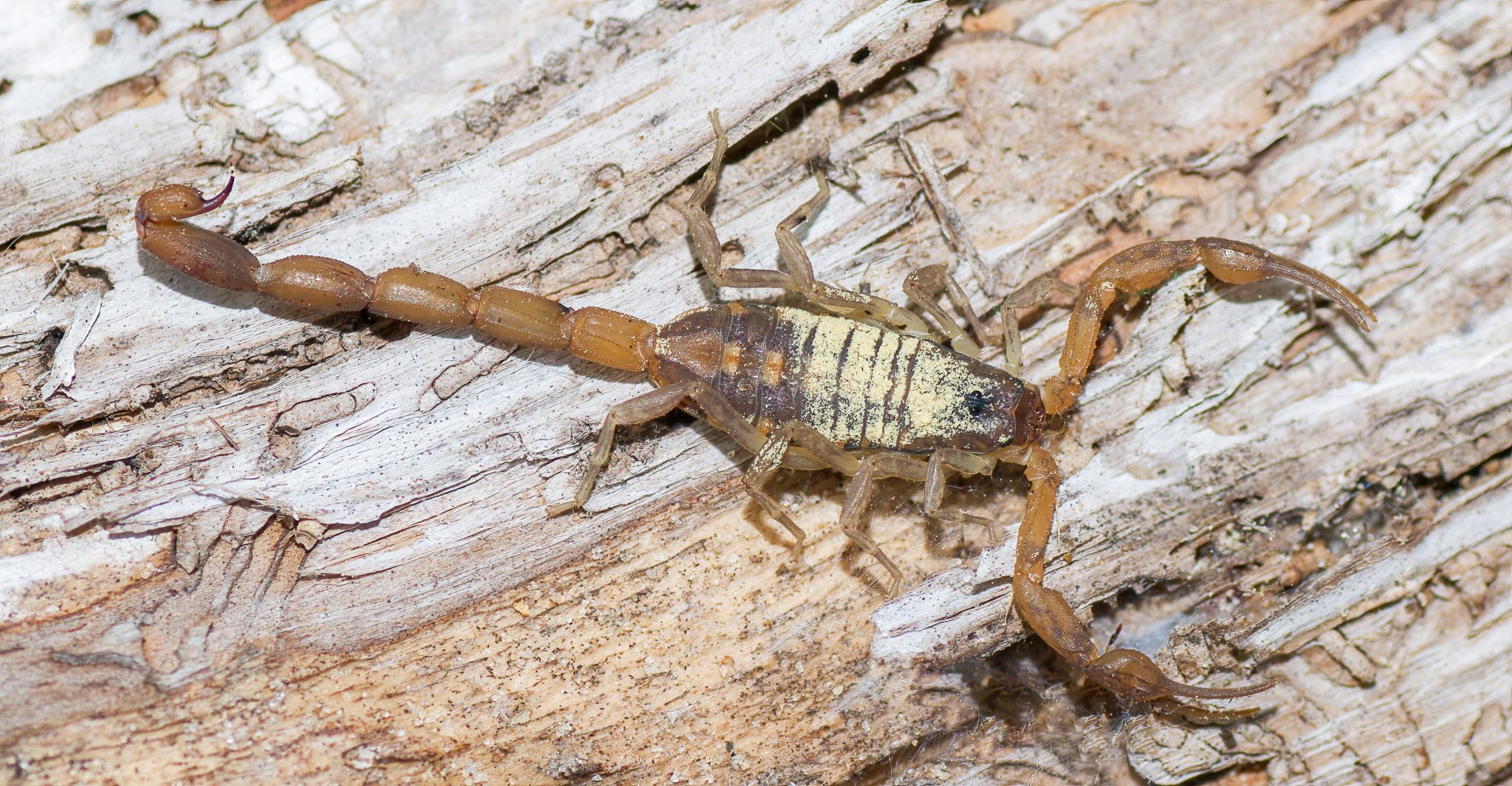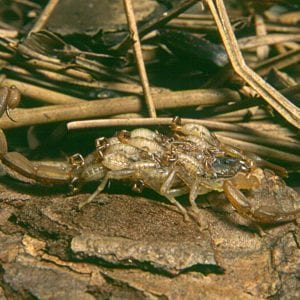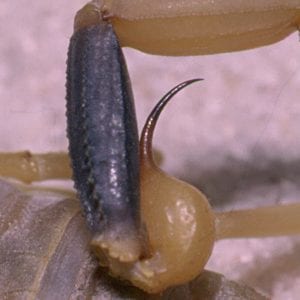Home

Scorpions are arachnids, meaning they have eight legs. They also have a set of front pinchers. The scorpion species native to Alabama are typically 2 inches (5 cm) or less in length. They naturally find their way into homes; therefore knowing facts about these creatures can make encounters less distressing.
Unlike most six-legged insects, scorpions do not lay eggs. Their young grow inside of the female and are born alive. They ride on their mother’s back (figure 1) until the young have undergone at least one molt (shed). After the first molt, the young leave their mother’s back to look for food and shelter. Scorpions periodically shed their exoskeleton (skin) before reaching maturity.
- Figure 1. Hentz striped scorpion (Centruroides hentzi) female with young on her back (Photo: Greg Greer)
- Figure 2. Hentz striped scorpion stinger (Photo: Greg Greer)
Scorpions do not build nests. They naturally live outdoors under logs, stones, loose tree bark (especially of dead trees and stumps), fallen snags, and wood piles. They also live in mulch, pine nuggets, and pine straw.
Scorpions are opportunistic predators of invertebrates. Their natural prey consists of spiders and insects as well as other arthropods small enough for them to subdue. They are important in this regard as a source of biological control. Scorpions use the pinchers to grab and tear apart their prey. They use the stinger situated at the tip of the tail to inject the victim with lethal venom (figure 2). The word lethal applies only to small insects and spiders. No scorpion species native to Alabama are known to be of serious concern to humans or their pets.
Scorpion Identification
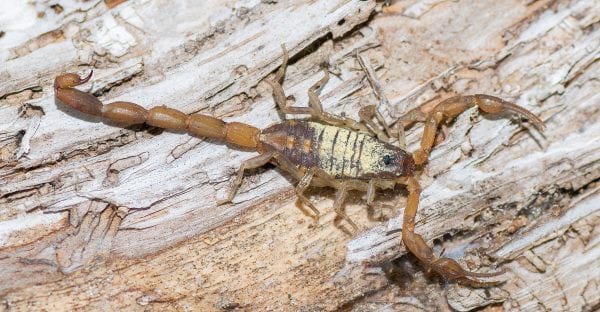
Figure 3. Full view of scorpion body parts
Scorpions are easy to distinguish from other arthropods (six-legged insects and eight-legged spiders) by their flattened body shape (not very thick from back to belly). This is known biologically as dorso-ventrally flattened.
Scorpions exhibit a segmented body that is broadly joined to the head (figure 3). The head bears eyes and one pair of formidable pinchers (also called pedipalps). The body is differentiated into two parts: a broad front portion bearing eight legs (four pairs) and a much narrower long tail extending from the rear portion of the body. The terminus of the tail is bulbous with a thin spike at the end, which is the stinger.
Common Scorpions in Alabama
Three types of scorpions can be found in Alabama. Of these, only two species are native and commonly find their way into garages, basements, and homes (figure 4).
Alabama’s native scorpions are fairly small. One is the Hentz striped scorpion (Centruroides hentzi). The other is the southern unstriped scorpion, also called southern devil scorpion (Vaejovis carolinianus).
Range
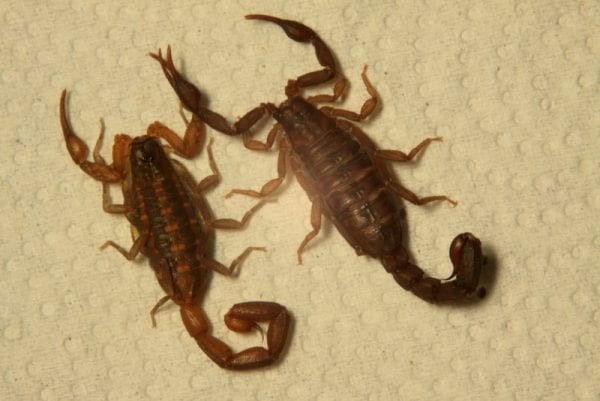
Figure 4. Hentz striped scorpion (left) and southern unstriped scorpion (Photo: Greg Greer)
The Hentz striped scorpion is found throughout Florida, the coastal plain of Georgia, and well into the coastal plain counties of Alabama. This scorpion is typically 2 inches (5 cm) or less in length. Large individuals may reach 2.5 inches (6.3 cm), although this is rare. It has a base color of brown with three yellowish stripes along its back, which at times may be a little obscure. Like many scorpions, males tend to be more slender in build, with elongated tail segments. This species is an obligate coastal plain species, thus requiring sandy substrates.
The southern unstriped scorpion, aka southern devil scorpion, habituates the southeastern part of the United States and the piedmont and mountain areas of Alabama. This scorpion is usually less than 2 inches (5 cm) in length, including the long, slender tail, and is most often uniform in color. The color may vary from blackish to dark brown to dark gray. It is the only scorpion found in its range that covers much of the piedmont and mountain areas in central and northern Alabama. Range is often the best indication of the species in your area.
Scorpion Inside, No Reason to Hide
Scorpions occasionally enter houses or garages or are outside around patios. Driven by cold, rain, or drought, they wander into homes looking for shelter, moisture, and prey. Scorpions can find remarkable ways to get into structures through openings or cracks only 1/8-inch wide. They can easily enter under door jams and windows unless these are sealed very tightly. They also find their way into homes via inadequately sealed pipes inside of walls. A typical entry point is where pipes enter under cabinets such as in kitchens and bathrooms.
Scorpions are nocturnal (active at night), shy, and secretive, wandering around on floors and sometimes on walls in search of prey. In most cases, they will eventually die indoors from dehydration and starvation.
Effects of a Scorpion’s Sting
Scorpions are known for their painful, venomous sting. Fortunately, scorpions native to Alabama are not potentially lethal to humans.
Under normal circumstances, a sting can be painful, akin to a wasp sting but with a slightly different sensation. It may be described as a sharp feeling accompanied by a burning sensation that is usually short-lived. The pain often subsides or is completely gone within 30 minutes. The resulting sting may remain swollen and be quite itchy for a few days.
Scorpion stings are quite common and typically result in localized pain only, unless a person is hypersensitive to the venom. Anyone stung by a scorpion should be monitored for a more severe reaction. Allergic reactions are a medical emergency requiring prompt medical care. When in doubt, call 9-1-1.
Scorpions are shy and not looking for people to sting. Stings usually occur when a scorpion is disturbed or handled. Hiding places to be aware of include inside shoes or bedroom slippers, under a damp dish cloth left on the kitchen counter, or occasionally in bed linens.
Dead scorpions should never be picked up by hand. A dust pan and brush is your best method for sweeping up dead scorpions. This will prevent an unpleasant sting in the event that one still has some life in it. Once dead, the scorpion’s tail will usually straighten out, but don’t use this as an indication that a scorpion is dead.
Scorpions don’t live in drains or drain pipes, don’t make nests inside homes, and don’t infest homes, as some might believe. One or two scorpions inside the house simply mean that one or two got in.
Scorpion Management
Scorpions prefer to live outdoors. They rest underground during the day and become active at night, looking for prey. Because of this, human campers should shake out their sleeping bags before bed and shake out their shoes before putting them on to avoid accidental close contact.
Outdoors, scorpions hide in leaf piles or under the loose bark of trees and logs, logs, wood stacks, and stones. Around homes, they prefer woodpiles, crumbling stone, brick foundations, and in the crawlspace of a house, particularly around stored lumber.
Nonchemical Methods
If you have scorpions entering your home, the following nonchemical methods should be considered first:
- Carefully inspect and clean up outdoor areas where they naturally live. Suggestions include, but are not limited to, the following:
- Remove all trash and debris. Always wear gloves when handling firewood or cleaning up debris piles.
- Store firewood and lumber off the ground and away from your house.
- Remove unnecessary rocks.
- Keep the area dry.
- Use small gravel as groundcover immediately adjacent to the home.
- Seal any openings in outside walls with mortar or caulking.
- Plug weep holes in stone or brick veneer structures with copper mesh, pieces of nylon scouring pad, small squares of screen wire, or steel wool. Steel wool will rust when wet, so it should be used only on dark-colored facades.
- Install weather stripping around loose-fitting doors and windows.
- Use sealant around roof eaves, pipes, and any other cracks in the structure. Great Stuff is a spray Styrofoam that works well in sealing around pipes.
- Keep window screens in good repair. Make sure they fit tightly in the window frame.
Chemical Control
Use chemical control only if the scorpion problem persists, which is rare, after applying recommended nonchemical measures. If you decide to use chemical control, consider these guidelines:
- One technique to treat scorpions is to concentrate them into a preferred habitat by spreading wet burlap or cloth on the ground near suspected infested areas. By grouping scorpions, chemical sprays can be applied to the collected individuals.
- Outside perimeter treatment should consist of directing repellent products at potential entry points of the house.
- When using pesticides, it is important to consider children and pets that live in your household. You must strictly follow the guidelines indicated for safe application where children and pets reside.
- Check the pesticide label carefully to make certain that the product may be used for scorpions and that it is approved for indoor use, if that is the intended treatment area. Follow all label instructions exactly.
Before taking any chemical measures, remember that scorpions are natural enemies of small arthropod pests and should be protected rather than killed. If a heavy infestation of scorpions is a problem, contact a pest control professional. Professionals have access to products and methods not available to the general public.
Xing Ping Hu, Extension Specialist, Professor, Entomology, Auburn University; Greg C. Greer, Greg Greer Enterprises, Inc.
Revised June 2021, Scorpion Management in Residential Homes, ANR-2259

